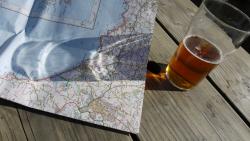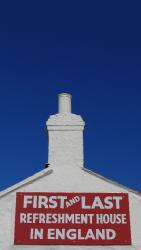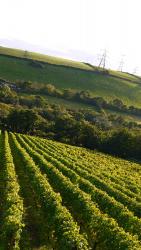 ‘So you’re a committed Cornwall fan?’ asked my friend after picking up my Twitter missives which I’d sent from her home county. Truly, I had fast grown fond of its almost balmy biscuit coloured beaches, tranquil harbour havens and miles of wild moors with eerie standing stones. When the vista was bathed under a broad sunset, as at Lizard Point, I could momentarily sense why locals might desire independence from the bustle of other parts of England.
‘So you’re a committed Cornwall fan?’ asked my friend after picking up my Twitter missives which I’d sent from her home county. Truly, I had fast grown fond of its almost balmy biscuit coloured beaches, tranquil harbour havens and miles of wild moors with eerie standing stones. When the vista was bathed under a broad sunset, as at Lizard Point, I could momentarily sense why locals might desire independence from the bustle of other parts of England.
I stayed at The Old Stores, a little cottage lined with canvases by its artist owner. Although most depicted Cornwall, there were others of Manhattan – fitting considering I’d visited the week before. Its cast iron stove made lulling breathing noises as it glowed, while windows set in thick walls framed the ever-changing waters at Porthleven, the UK’s most southerly port and once a notorious black spot for sailing ships.
 Sometimes making use of the cottage’s kitchen, but mostly eating out, I wasted no time in sampling the region’s bounty of meaty crabs, saline oysters and hardy cattle. Although, my trek to Land’s End did not end, as hoped with a well earned tea in the UK’s first and last refreshment house, there were plenty of successes.
Sometimes making use of the cottage’s kitchen, but mostly eating out, I wasted no time in sampling the region’s bounty of meaty crabs, saline oysters and hardy cattle. Although, my trek to Land’s End did not end, as hoped with a well earned tea in the UK’s first and last refreshment house, there were plenty of successes.
In Porthleven, ‘Kota’ (Maori for shellfish) served the dish of the week. Half Maori, a quarter Chinese and a quarter Malaysian, chef/owner Jude Kereama’s Asian influence was perfectly captured in plump, supple Falmouth Bay oysters insulated in brittle tempura and served on crisp lettuce leaves. These were dotted with balanced homemade wasabi tartare and offered with umami laden sherry-shallot vinegar. Alas, main courses failed to excite, including a monkfish sadly smothered in froth evocative of an epileptic cuckoo.
Also harbour side, I was impressed by bone marrow and sweet corn fritters at the romantic ‘Amélies at The Smokehouse’ which was actually originally a sail loft.
After a two hour moorland walk looking for the illusive nine maidens stone row, a seat by the fire at ‘The Tinners Arms’, Zennor proved a welcome reward. Originally built in 1271 as an inn and watering hole for the masons building the town’s church St. Senara, and later commended by D.H. Lawrence, it is now run by a former manager of London’s Kensington Place restaurant. ‘The trick is to constrict it at the sides,’ said the landlady to the barman as she showed him how to build-up the log fire. The highlight was gently baked plover, a wading bird characterised by its relatively short bills and fleshy taste.
As their third eatery in Soho gathers momentum, I settled into the idyllically sited Helford Ship Inn which belongs to raisers of over five millions oysters a year, the Wright Brothers. Sweetly salted mineral native and meatier pacific oysters were kindly priced the same (£1 a pop). I also fed well on a well fed crab and, as the sun struck them in their glass tankard, luminous prawns. In an effort to stroll off lunch, I wandered into the National Trust’s Glendurgan Gardens close by, which are complete with a very difficult windy maze.
Although originally booked into Fifteen, Watergate Bay my vanity over sanity Italian car chose the journey there to lose its oil. The damage was such that the recovery service found me by following its black trail on the tarmac. However, the restaurateur of nearby St. Merryn’s Seven Bays Bistro helped turn calamity into a calm feed, prescribing her homemade enthusiastically spiced fishcake of salmon and pollock as well as several glasses of wine. Also of note were her daughter’s stylised portraits of cows wearing human expressions which reminded me of the inhabitants of Jersey.
 I ate several Cornish pasties, the meat and vegetable filled pastry pocket which once formed the lunch of tin miners. Well insulated to withhold temperature, it traditionally incorporates a long crimped handle, the story going that miners wouldn’t then get the rest of it dirty. My best example was the organic version at the Eden project, savoured after a humid walk in a spectacular simulated rain forest. I would now love to try the more exotic seeming crab, chilli, green bean and coconut version from beauty journalist turned chef, Ravinder Bhogal.
I ate several Cornish pasties, the meat and vegetable filled pastry pocket which once formed the lunch of tin miners. Well insulated to withhold temperature, it traditionally incorporates a long crimped handle, the story going that miners wouldn’t then get the rest of it dirty. My best example was the organic version at the Eden project, savoured after a humid walk in a spectacular simulated rain forest. I would now love to try the more exotic seeming crab, chilli, green bean and coconut version from beauty journalist turned chef, Ravinder Bhogal.
Stein’s Fish and Chips canteen is part of TV chef, Rick Stein’s Padstow empire (some call it ‘Steinville’) of six restaurants and three shops. Despite limited opening hours and maladroit service, skate in batter proved acceptable, although mushy peas lacked assertiveness. A short cruise away, Rock is the preserve of the rich who take to water. Chef Nathan Outlaw caters for them here, although I’d eaten too many chips to consider his finely tuned food. Instead, flutes of English liquid sunshine, the sparkling rosé at Camel Valley vineyard’s terrace was a tonic, sipped in sight of a coach-load of students eager to begin a winery tour…
